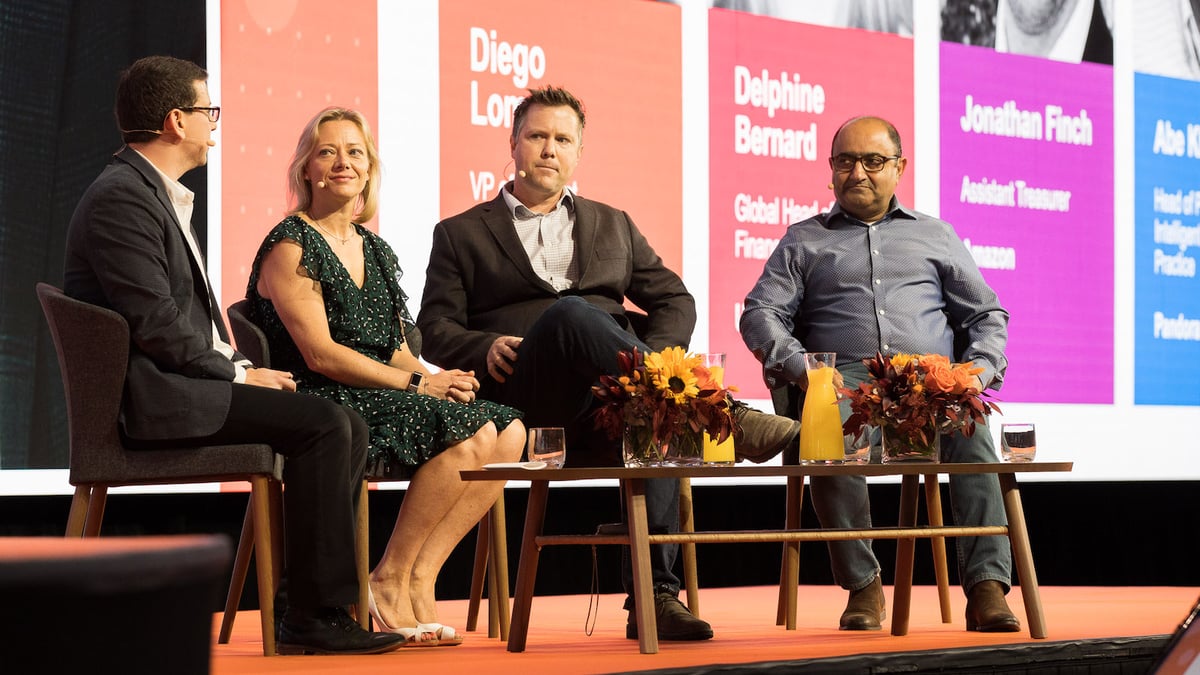How Automation Quick Wins Help Amazon, Uber, and SiriusXM/Pandora Stay Ahead of the Competition
How Automation Quick Wins Help Amazon, Uber, and SiriusXM/Pandora Stay Ahead of the Competition

Wouldn't it be great to put the leaders of the world's most innovative companies in a room and ask them how they've used automation to succeed?
Well, last month, at FORWARD III in Las Vegas, we did just that. I sat down with leaders from Amazon, Uber, and SiriusXM/Pandora to get their advice on staying competitive in the 'automation first' era.
It boiled down to one thing: get quick wins with automation early to build the momentum for future, cutting-edge innovation.
In this article, I'll share how Amazon, Uber, and SiriusXM/Pandora set themselves up for automation success to remain competitive.
What do quick wins look like?
Quick wins come from automating 'low-hanging fruit' processes. These early victories show stakeholders and employees the immediate Robotic Process Automation (RPA) benefits and ROI.
Often, these successes come from the proof of concept (PoC) or pilot processes. Pilot automations help companies ramp quickly and build enthusiasm for automation tools among C-suite leaders. This, in turn, gets decision-makers excited about digital transformation and fosters early buy-in.
We started off with a pilot because we wanted to make sure that this thing is real. We wanted to touch, feel, and experience it.
Abe Khaleeli, head of PMO and the intelligent automation practice, SiriusXM/Pandora
Quick-win processes don't need a high level of in-house expertise to put them in place. This, as Khaleeli found, makes the resulting automation scalable and achievable across business and operations teams. This rang true for all workflows that were already rule-based and organized.
When Khaleeli dove into automation, he knew one of the first things they had to tackle was their legacy Pandora processes.
Additionally, Amazon started its journey by automating their tax-withholding and cash-positioning processes. This reduced the number of hours spent on each transaction.
While SiriusXM/Pandora’s and Amazon's pilot processes were different, both gave the companies momentum to push digital transformation forward.
How quick wins set you up for an automation first journey
Automation is a marathon, not a sprint. Like marathon runners, your automation strategy—and the team that supports it—needs quick sources of energy to push on.
Delphine Bernard, global head of finance operations at Uber, explains how transformation is a journey:

Quick wins are like the energy-boosting gel-pack snacks of your automation journey. They help push your software robots along their evolutionary track. This early success not only builds momentum but convinces skeptics, too.
At SiriusXM/Pandora, the C-suite was eager to evaluate the company's automation initiatives to see if RPA could deliver on its promises. With the help of fast, scalable pilot programs, they were able to show skeptics that automation was worthwhile.
How quick automation wins help shift legacy mindsets
The adoption of new technologies is rarely the biggest challenge of a digital transformation journey. In most cases, it's letting go of legacy systems and mindsets that trip up automation strategies.
It can be hard to convince skeptical employees and C-suite leaders that the processes that made your organization successful might need to be redone.
As companies like Amazon know, however, inefficient workflows prevent innovation when it counts.
You don’t need an existing culture around innovation and new technology to embrace and benefit from automation, however. In actuality, the benefits of the automation first era can be greatest for companies who are new to creating a digital workforce.
This is because the ROI of automating processes that are bogged down by manual, cumbersome work is high. The lessons learned from these early automations help your company tackle more-complex workflows in the future.
This is exactly what SiriusXM/Pandora set out to do. In the beginning, their leadership gave them the blessing to explore automation but weren’t sure it would pan out. These early successes showed C-suite leaders that automation was worthwhile and scalable.
Quick automation wins benefit companies rooted in innovation, too
Getting quick wins isn’t just about convincing the doubtful about the promise of automation. Companies who value new technologies can also use the momentum of these victories.
In Amazon’s case, their goal of digital transformation caused them to rethink how they streamlined manual and repetitive work. In the past, these cumbersome tasks might have been moved to an offshore center.

Instead, Amazon is investing $700 million into its workforce. One hundred thousand of its workers of its United States (U.S.) workers—about one-third of its workforce—will receive approximately $1,000 of upskilling education per person every year. With automation, Amazon can create a digital workforce that empowers their newly trained employees to complete these processes faster and better.
At Uber, the company had already created a culture that encouraged people to try new things. The company knew their employees would be more likely to embrace the potential of automation.
However, employee enthusiasm sometimes isn't enough, even at a company rooted in innovation. To make automation endure, these early successes must show how RPA and intelligent automation can address each stakeholder's goals.

Some stakeholders are risk-averse and don’t want to see change. Others are the exact opposite and will bring every process they can forward for automation, even ones that aren’t the best candidates. With a product like UiPath Task Mining, organizations can thread between those concerns and identify the best processes for automation.
To keep every stakeholder on board, automation evangelists must find these opportunities and show what RPA and AI can do for the company at every level.
The leaders of innovative companies like Amazon won’t believe the hype without evidence. Early successes show that automation has tangible benefits that can scale across the enterprise.
Amazon’s all about leadership principles, and it really governs everything we do, (including) all our major decisions. We challenge each other and we debate.
Jonathan Finch, assistant treasurer, Amazon
How the quick wins of today ensure your competitive edge of tomorrow
The leaders of today’s top companies know that those who hesitate to adopt new technologies quickly fall out of relevancy.
Industry leaders not only gain immediate ground by using automation; they also set the foundation for future innovation and success in the process.
Quick automation wins help build the basis of future success by:
Saving money on manual processes so companies can invest in better talent
Giving companies a road map of future ways to improve
Providing businesses with a head start on competitors who haven’t embraced the automation first era
Today's industry leaders must do more with less. It's unsustainable to keep hiring qualified young talent to do manual work below their skill levels. Frankly, most of today's tech-savvy college graduates with high-tech degrees also aren't as willing to do lower-tech jobs.
The college graduates today are much more technically inclined than I was when I came out of college. The younger generation who are coming into the workforce love this stuff.
Jonathan Finch, assistant treasurer, Amazon
This puts companies like Amazon in a tough spot. They've built their reputation on their ability to scale by hiring, but they need to reexamine how their human workforce exists with a digital one.
Automation lets companies focus staffing dollars on letting the best talent do what they do best: cognitive, creative work. While competitors sink money into expensive support staff, companies like Amazon can use the cost savings from automation to invest in research and development.
Through automation, employees and leaders have room to focus on developing and using their expertise where it counts.
Instead of focusing on quotas alone, employees are given the freedom to think about how to do the work they’re good at, in a better way.
Quick wins aren’t just about immediate results, either. Beyond the workforce benefits, these victories showcase where your automation can make the biggest difference at scale. The necessary intake and process auditing that comes with a pilot program gives companies a hit list of ways to trim fat and errors.
This means that when your competitors are spinning their wheels integrating automation next year, you'll already be evolving.
Join Amazon, Uber, and SiriusXM/Pandora in using automation to create a better business
The standards that today’s industry leaders must face are only getting higher. And, as the automation first era rapidly evolves, it can be hard to know what tools are the best for getting those all-important quick wins.
That’s where UiPath and our network of expert partners come in.
The UiPath Enterprise RPA Platform empowers your organization across the entire automation lifecycle—from planning and building automations to running your digital workforce and measuring its achievements. With UiPath, you’re not adding more tools to the developer or IT tech stack; you’re democratizing access to RPA and the future of work.
Did you miss hearing from top-of-industry leaders like Amazon, Uber, and SiriusXM/Pandora at FORWARD III? Get our event pack today to see how the world’s top companies are using UiPath to reboot work and stay ahead of the competition.

Chief Marketing Officer (CMO), Ada
Get articles from automation experts in your inbox
SubscribeGet articles from automation experts in your inbox
Sign up today and we'll email you the newest articles every week.
Thank you for subscribing!
Thank you for subscribing! Each week, we'll send the best automation blog posts straight to your inbox.



